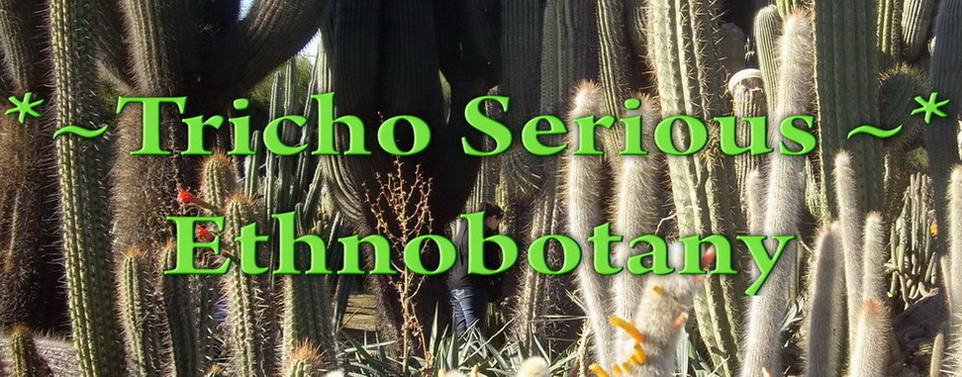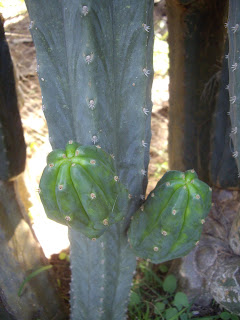Trichocereus Pachanoi, the San Pedro Cactus, is a fast-growing columnar cactus native to the Andes Mountains of Peru between 2000–3000 m in altitude. It is also found in Argentina, Bolivia, Chile and Ecuador, and it is cultivated in other parts of the world. Uses for it include traditional medicine and traditional veterinary medicine, and it is widely grown as an ornamental cactus. It has been used for healing and religious divination in the Andes Mountains region for over 3000 years. Currently it is believed to help with nervous conditions, joint problems, drug addictions, cardiac disease, and high blood pressure. Trichocereus Pachanoi contains hordenine and it has been shown that hordenine, N,N-Dimethyl-hydroxyphenylethylamine, exhibits an inhibitory action against at least 18 strains of penicillin resistant Staphylococcus bacteria.
The plant is light to dark green, sometimes glaucous, and has 4–9 (usually 5–7) ribs. Groups of 1–4 small, yellow to light brown spines are located at nodes which are spaced evenly, approximately 2 cm apart, along the ribs. Trichocereus Pachanoi can grow up to 5 metres (16 ft) tall and have multiple branches, usually extending from the base. The tallest recorded specimen was 12.2 metres (40 ft) tall. The cactus blossoms at night with flowers up to 20 centimetres (8 in) in diameter, and it bears red, tasty fruit.
There is alot of conjecture in recent times over this plant. Has also been known as the Backeberg Clone, although that is pure mythology, Backeberg never grew the plant in question as you can see from Backebergs own pics in his book Die Cactaceae, it's a very different Pachanoi that he grew.
It has also been known as the 'Pachanot', which I find to be a misleading term. The 'Pachanot' theory which has in no way been proven or accepted by any actual botanists states, basically that the predominant cultivar Pachanoi, isn't a Pachanoi but something else. Based on the plant having white flower hair, instead of black as it was originally described to have and it being slightly varied from other Pachanoi forms.
From a distance, it looks exactly like alot of black haired bona fide Pachanoi I've seen. Especially when it is in the ground, potted plants are held back in a lot of ways, disguising a plants true look sometimes. And it does indeed have black hair on the flowers, just white hair also. The hairs also tend to sun bleach, making them whiter. Up close the differences are negligible, no way near as much variation as some other accepted forms of Pachanoi. While it is quite distinct, no where near enough for it to be another species when the other varied forms are considered to also be pachanoi.
But that also depends on what you define as a Pachanoi, some people define Peruvianus as Pachanoi. The lines between the different Trichocereus is very blurry. To me, the name 'Predominant Cultivar' or 'PC' Pachanoi is perfectly acceptable as an accuratte description. It is the predominantly cultivated recognized Pachanoi form, simple.
I received my cuts of this cactus from Fields Cactus Farm, where the proprieter Robert informs me the that he recieved the plant in the 50's but is not sure where from. Alot of the plants out there come from Ritter and it does suit the time frame to be from him. Interestingly the plant looks exactly the same as the Trichocereus Pachanoi: (Br.&R.) FR 567 from the Chan Chan Valley Ecuador, that is pictured on Bob Resslers Columnar-Cacti website (which can be found in the links section) and his Desert Gardens pictures, even showing the same white hairs on the flower. With that being the case, I have no problem what so ever calling it a Pachanoi. Most likely from the Chan Chan Valley of Equador via Friedrich Ritter.
But that is of course just for me. In your garden you can call your plants whatever you want too. Don't let other peoples rules get in your way, do what you want. When you are looking after them, when they are in your garden, they are yours and no one elses. It's upto you.
Is a fast growing very hardy plant, tough as nails. Probably why it is everywhere. Really good for grafting other slower growing cacti too. Nice looking plant that needs very little care. Here's some pics ~*
8th March, 2012 Update ~*
More pics :)
There is alot of conjecture in recent times over this plant. Has also been known as the Backeberg Clone, although that is pure mythology, Backeberg never grew the plant in question as you can see from Backebergs own pics in his book Die Cactaceae, it's a very different Pachanoi that he grew.
It has also been known as the 'Pachanot', which I find to be a misleading term. The 'Pachanot' theory which has in no way been proven or accepted by any actual botanists states, basically that the predominant cultivar Pachanoi, isn't a Pachanoi but something else. Based on the plant having white flower hair, instead of black as it was originally described to have and it being slightly varied from other Pachanoi forms.
From a distance, it looks exactly like alot of black haired bona fide Pachanoi I've seen. Especially when it is in the ground, potted plants are held back in a lot of ways, disguising a plants true look sometimes. And it does indeed have black hair on the flowers, just white hair also. The hairs also tend to sun bleach, making them whiter. Up close the differences are negligible, no way near as much variation as some other accepted forms of Pachanoi. While it is quite distinct, no where near enough for it to be another species when the other varied forms are considered to also be pachanoi.
But that also depends on what you define as a Pachanoi, some people define Peruvianus as Pachanoi. The lines between the different Trichocereus is very blurry. To me, the name 'Predominant Cultivar' or 'PC' Pachanoi is perfectly acceptable as an accuratte description. It is the predominantly cultivated recognized Pachanoi form, simple.
I received my cuts of this cactus from Fields Cactus Farm, where the proprieter Robert informs me the that he recieved the plant in the 50's but is not sure where from. Alot of the plants out there come from Ritter and it does suit the time frame to be from him. Interestingly the plant looks exactly the same as the Trichocereus Pachanoi: (Br.&R.) FR 567 from the Chan Chan Valley Ecuador, that is pictured on Bob Resslers Columnar-Cacti website (which can be found in the links section) and his Desert Gardens pictures, even showing the same white hairs on the flower. With that being the case, I have no problem what so ever calling it a Pachanoi. Most likely from the Chan Chan Valley of Equador via Friedrich Ritter.
But that is of course just for me. In your garden you can call your plants whatever you want too. Don't let other peoples rules get in your way, do what you want. When you are looking after them, when they are in your garden, they are yours and no one elses. It's upto you.
Is a fast growing very hardy plant, tough as nails. Probably why it is everywhere. Really good for grafting other slower growing cacti too. Nice looking plant that needs very little care. Here's some pics ~*
8th March, 2012 Update ~*
More pics :)
9th, April 2012 Update~*
Some more pics from out Fields :)





















No comments:
Post a Comment